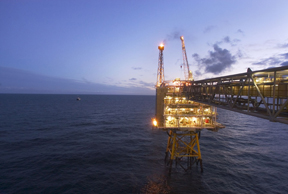|
News Notes
Climate
Giving carbon a deep-sea burial
 Although U.S. carbon dioxide emissions were virtually flat over the past year, emissions have still increased by close to 20 percent since just 1990, according to the U.S. Energy Information Administration. While many people are calling for an immediate reduction in emissions, others are looking toward ways to dispose of the excess carbon dioxide. Burying the gas in sediments below the ocean could be a potential solution, according to new modeling efforts.
Although U.S. carbon dioxide emissions were virtually flat over the past year, emissions have still increased by close to 20 percent since just 1990, according to the U.S. Energy Information Administration. While many people are calling for an immediate reduction in emissions, others are looking toward ways to dispose of the excess carbon dioxide. Burying the gas in sediments below the ocean could be a potential solution, according to new modeling efforts.
Norway’s Statoil energy company is both producing gas and injecting carbon dioxide into the depleted gas field at the Sleipner field in the North Sea. New research is suggesting that carbon dioxide could be injected into deep-sea sediments as well. Photograph is courtesy of Statoil.
Over the years, the idea of storing or “sequestering” carbon dioxide in geologic formations on land or under the sea has been gaining popularity. Since 1996, Norway has been injecting carbon dioxide into depleted oil and gas fields in the North Sea. Other countries are developing similar strategies as part of their emissions-control plans. This method now also looks promising for much of the United States, which has many on-land brine aquifers and oil and gas fields, says Kurt Zenz House, a graduate student at Harvard University.
The major challenge, however, is keeping the gas in place once it is injected, House says. Carbon dioxide’s natural tendency is to seek a way out of a geologic reservoir, so any uncapped wells or natural fractures in the reservoir rocks would potentially allow it to leak out. Furthermore, areas that do not have the thick sedimentary basins necessary to store the gas but have large populations, such as large parts of Japan or Australia or much of the East Coast of the United States, would simply be out of luck for onshore storage, says Susan Hovorka of the Bureau of Economic Geology at the University of Texas in Austin.
In thinking about new ways to store the gas that do not rely on geological formations to trap carbon dioxide, House and colleagues turned to the deep ocean. The physical properties of deep-sea sediments and how carbon dioxide reacts at the low temperatures and high pressures beneath the seafloor, they reasoned, ensure that the carbon dioxide will not escape.
To test the idea, they used models to find the specific ocean and sediment depths where gravity and hydrates provide “a double seal,” House says. Those depths were more than 3,000 meters below the surface of the ocean and several hundred meters deep in marine sediments.
Because carbon dioxide is denser than water at certain pressures and temperatures, gravity prevents the gas from rising; instead, it pools out laterally in the pore spaces of the sediments, House says. Injecting the gas below the formation zone for hydrates — solid compounds of water and gas, in this case carbon dioxide, that are stable at particular temperatures and pressures — caps the “pool,” the team found. Given these two separate seals, even large perturbations, such as earthquakes or undersea landslides, would be unlikely to destabilize the carbon dioxide and release it into the ocean, House and colleagues wrote in the Aug. 15 Proceedings of the National Academy of Sciences.
“The physics of this approach seem right to me,” says Dan McCorkle, a geochemist at the Woods Hole Oceanographic Institution in Massachusetts. “And the promise for long-term sequestration is good.” The wildcard, he says, is the cost of capturing the carbon at electricity plants, transporting it offshore via either pipeline or barges, and injecting it. Although House’s team has made only preliminary cost estimates of deep-sea burial, the costs appear to be just marginally higher than sequestering the carbon in geological formations onshore, House says.
But before costs even come into play, the public and political will needs to be strong enough in the United States to push through such projects, Hovorka says. In the same way that it is hard to get offshore oil and gas exploration approved, she says, it will likely be difficult to get offshore injection approved. A possible concern is that the rigs and platforms offshore might damage coastal beach environments. Even though geologists “have quite a bit of confidence” that they can inject the carbon dioxide into the seafloor without harming the environment, until the public begins to understand how such a process works, it will be hard to get approved.
Regardless, Hovorka says, House’s team has shown that deep-sea burial is a technical option. The team needs to test their modeling in the real world, however, to determine if hydrates will actually form a seal to prevent the carbon dioxide from leaking out, Hovorka adds. And indeed, House and colleagues do plan to do just that, hopefully in deep basins off the coast of California or in the Gulf of Mexico, House says.
In the meantime, “we need to try to cut the size of the carbon dioxide spike over the next few centuries, as we don’t know if we’d be happy living in a world with double or triple the amount of carbon dioxide in the atmosphere,” McCorkle says. Carbon sequestration in any form is only a partial solution, he says.
Megan Sever

 Subscribe
Subscribe

